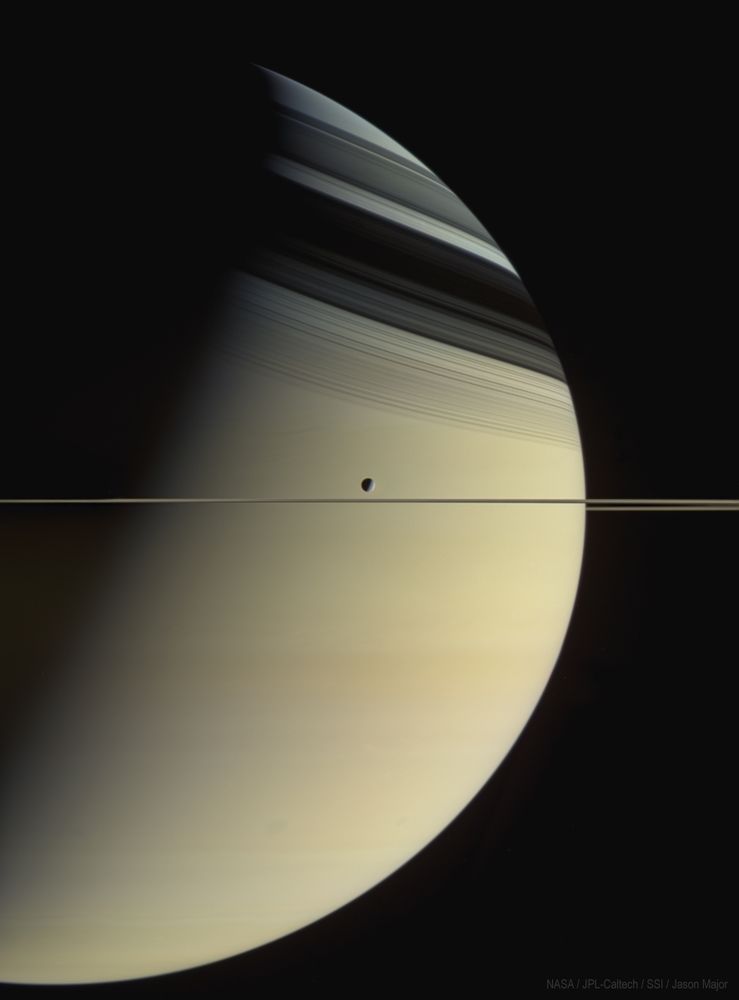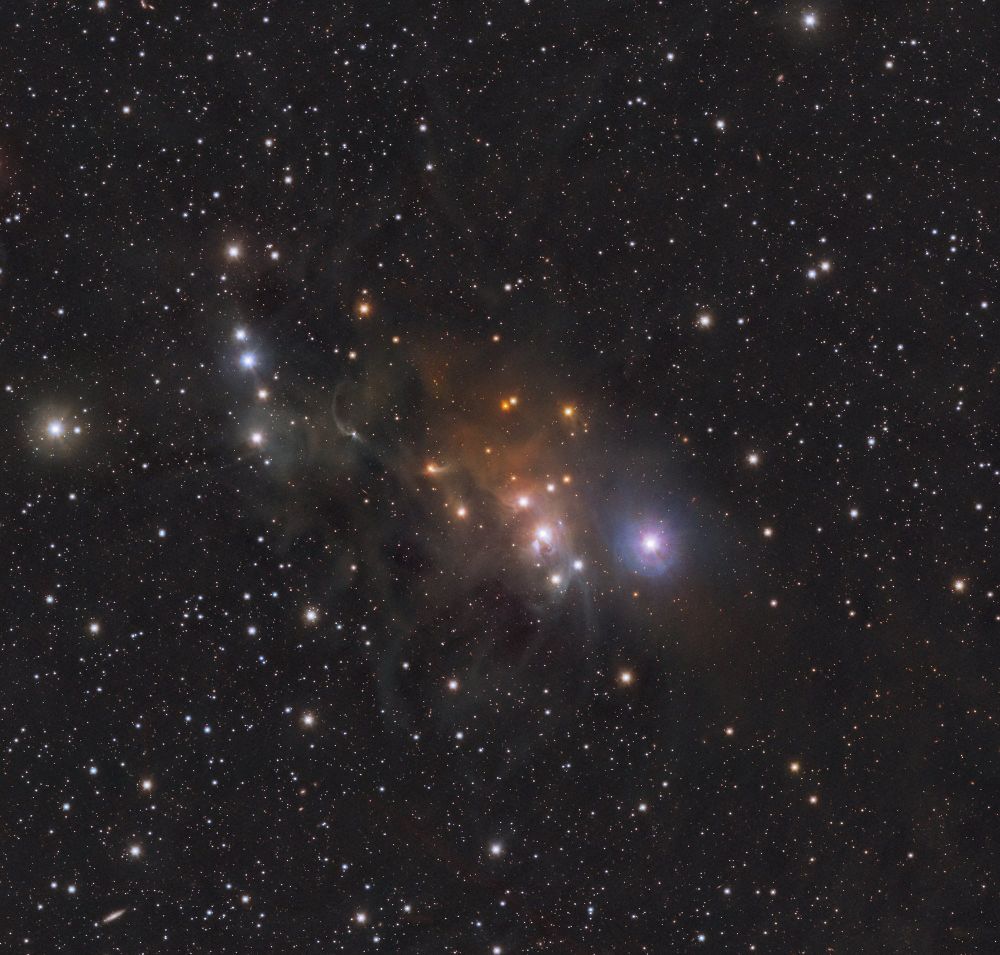Credit: NASA, ESA, Hubble Heritage (STScI/ AURA)-ESA/Hubble Collaboration
03.11.2025 13:33 — 👍 0 🔁 0 💬 0 📌 0

Close-up of Centaurus A, an active galaxy with star clusters and dark dust lanes. Credit: NASA, ESA, Hubble Heritage (STScI/ AURA)-ESA/Hubble Collaboration
Astronomy Picture of the Day (Feb 22, 2020)
At just 11 million light-years away, Centaurus A is the closest active galaxy, showcasing star clusters and dark dust lanes in this Hubble close-up.
apod.nasa.gov/apod/ap200222.html
03.11.2025 13:33 — 👍 0 🔁 1 💬 1 📌 0
Credit and Copyright: Thomas Carpentier (Used with permission)
03.11.2025 11:30 — 👍 0 🔁 0 💬 0 📌 0

Insufficient descriptive information provided Credit and Copyright: Thomas Carpentier (Used with permission)
Thomas Carpentier (@thocarp.bsky.social) on Flickr (Nov 2, 2025)
M16, or the Eagle Nebula, showcases a beautiful area where new stars are being born amidst cosmic dust and gas.
flic.kr/p/2rD4JDu
03.11.2025 11:30 — 👍 0 🔁 0 💬 1 📌 0
Credit: NASA, ESA, SSI, Cassini Imaging Team
03.11.2025 07:30 — 👍 0 🔁 0 💬 0 📌 0

Crescent Saturn with its rings and moons, captured by the Cassini spacecraft in 2007. Credit: NASA, ESA, SSI, Cassini Imaging Team
Astronomy Picture of the Day (Jul 7, 2019)
Crescent Saturn showcases its rings and moons in this stunning 2007 image captured by Cassini, providing a view not visible from Earth.
apod.nasa.gov/apod/ap190707.html
03.11.2025 07:30 — 👍 0 🔁 0 💬 1 📌 0
Credit: ESA/Hubble & NASA, A. Barth, R. Mushotzky
03.11.2025 05:31 — 👍 0 🔁 0 💬 0 📌 0

A luminous image of the active galaxy Z 229-15 captured by the Hubble Space Telescope. Credit: ESA/Hubble & NASA, A. Barth, R. Mushotzky
NASA Hubble Space Telescope on Flickr (Jan 2, 2024)
Z 229-15, an active galaxy in the constellation Lyra, lies 390 million light-years from Earth and is classified as an AGN, quasar, and Seyfert galaxy.
flic.kr/p/2pq4Vby
03.11.2025 05:31 — 👍 0 🔁 0 💬 1 📌 0
Credit: NASA, ESA, STScI; Judy Schmidt
03.11.2025 03:31 — 👍 0 🔁 0 💬 0 📌 0

An image of NGC 4536 showing star formation regions and dust clouds, with colors from various Hubble instruments. Credit: NASA, ESA, STScI; Judy Schmidt
Judy Schmidt (@geckzilla.bsky.social) on Flickr (Jan 14, 2017)
NGC 4536 displays areas of star formation and dust clouds, with colors derived from multiple Hubble instruments, highlighting its dynamic nucleus.
flic.kr/p/PYcvHB
03.11.2025 03:31 — 👍 0 🔁 0 💬 1 📌 0
Credit: NASA, Voyager 2; Jason Major
03.11.2025 01:31 — 👍 0 🔁 0 💬 0 📌 0

Close-up image of Neptune's moon Proteus taken by Voyager 2. Credit: NASA, Voyager 2; Jason Major
Jason Major (@jpmajor.bsky.social) on Flickr (Aug 25, 1989)
A close-up image of Proteus, Neptune's inner moon, taken by Voyager 2 on August 25, 1989, is a rare glimpse of this 400-km wide celestial body.
flic.kr/p/26c3sM4
03.11.2025 01:31 — 👍 1 🔁 0 💬 1 📌 0
Credit: Eric Coles (coles44)
02.11.2025 23:31 — 👍 0 🔁 0 💬 0 📌 0

Image of IC 1396, The Elephant Trunk, in H-alpha light. Credit: Eric Coles (coles44)
Eric Coles (coles44) on AstroBin (Mar 29, 2015)
IC 1396, also called The Elephant Trunk, is showcased in this stunning H-alpha image.
www.astrobin.com/168318/
02.11.2025 23:31 — 👍 1 🔁 0 💬 1 📌 0
Credit: NASA/JPL-Caltech/Simeon Schmauß
02.11.2025 21:31 — 👍 0 🔁 0 💬 0 📌 0

Aerial view of Belva crater with Perseverance Rover in the foreground, captured by Ingenuity helicopter during flight 51. Credit: NASA/JPL-Caltech/Simeon Schmauß
Simeon Schmauß (@stim3on.bsky.social) on Flickr (Oct 1, 2023)
During its 51st flight, Ingenuity provides a breathtaking look at Belva crater with the Perseverance Rover overlooking the scene on Sol 772.
flic.kr/p/2ovA9fD
02.11.2025 21:31 — 👍 0 🔁 0 💬 1 📌 0
Credit: ESO/D. Baade
02.11.2025 19:30 — 👍 0 🔁 0 💬 0 📌 0

Near-infrared image of the Moon's surface showing craters Bianchini, Mairan, and Sharp, east of Sinus Iridum. Credit: ESO/D. Baade
European Southern Observatory (@eso.org) images (Jan 15, 1999)
This near-infrared image captures the waning Moon's plains east of Sinus Iridum, highlighting craters Bianchini, Mairan, and Sharp during sunrise.
www.eso.org/public/images/eso9903e/
02.11.2025 19:30 — 👍 1 🔁 0 💬 1 📌 0
Credit: Jason Major
02.11.2025 17:31 — 👍 0 🔁 0 💬 0 📌 0

Insufficient descriptive information provided Credit: Jason Major
Jason Major (@jpmajor.bsky.social) on Flickr (May 5, 2005)
This image features Saturn alongside its moon Dione, showcasing the beauty of the planet and its celestial companion.
flic.kr/p/25vtmYU
02.11.2025 17:31 — 👍 1 🔁 0 💬 1 📌 0
Credit: NASA, JPL; Gordan Ugarković
02.11.2025 15:31 — 👍 0 🔁 0 💬 0 📌 0

Oblique view of Valhalla impact basin on Callisto taken by the Galileo orbiter. Credit: NASA, JPL; Gordan Ugarković
Gordan Ugarković (@ugordan.bsky.social) on Flickr (Jun 25, 1997)
An oblique view of Valhalla impact basin on Callisto, captured by the Galileo orbiter in 1997, processed to resemble natural color.
flic.kr/p/7o5gtp
02.11.2025 15:31 — 👍 1 🔁 0 💬 1 📌 0
Credit: Aster Cowart
02.11.2025 13:31 — 👍 0 🔁 0 💬 0 📌 0

Astronaut Dave Scott retrieving tools from the Lunar Rover at Hadley Rille during Apollo 15. Credit: Aster Cowart
Aster Cowart (@terrasabaea.bsky.social) on Flickr (Oct 8, 2015)
Dave Scott retrieves tools from the Lunar Rover at Hadley Rille, a collapsed lava tube, during Apollo 15's first extravehicular activity.
flic.kr/p/zwb5XC
02.11.2025 13:31 — 👍 0 🔁 0 💬 1 📌 0
Credit: ESO/Meingast et al.
02.11.2025 11:31 — 👍 0 🔁 0 💬 0 📌 0

Infrared image of the Chamaeleon Cloud (IC 2631), a reflection nebula illuminated by the star HD 97300. Credit: ESO/Meingast et al.
European Southern Observatory (@eso.org) images (Jul 17, 2023)
IC 2631, the Chamaeleon Cloud, is a reflection nebula illuminated by the bright star HD 97300, showcasing the star-making materials within.
www.eso.org/public/images/potw2329a/
02.11.2025 11:31 — 👍 0 🔁 0 💬 1 📌 0
Credit: NASA, JAXA, Lockheed Martin
02.11.2025 09:31 — 👍 0 🔁 0 💬 0 📌 0

Hinode views of the Venus transit on June 5, 2012. Credit: NASA, JAXA, Lockheed Martin
NASA's Marshall Space Flight Center on Flickr (Jun 5, 2012)
On June 5, 2012, Hinode provided remarkable views of the Venus transit, a rare event not to occur again until 2117.
flic.kr/p/cc9PHL
02.11.2025 09:31 — 👍 0 🔁 0 💬 1 📌 0
Credit: ESO
02.11.2025 05:30 — 👍 0 🔁 0 💬 0 📌 0

Planetary nebula ESO 577-24 with central star Abell 36 and an asteroid track, surrounded by distant galaxies. Credit: ESO
European Southern Observatory (@eso.org) images (Jan 22, 2019)
The planetary nebula ESO 577-24, captured by the VLT's FORS2, showcases its ephemeral glow, with an asteroid and distant galaxies adding to the cosmic tapestry.
www.eso.org/public/images/eso1902a/
02.11.2025 05:30 — 👍 0 🔁 0 💬 1 📌 0
Astrophysicist and science writer. My ongoing research lines include: Meteoritics, primordial planetary system materials, their physico-chemical properties, transport of volatiles to planets, planetary atmospheres and astrobiology. Saganist
Robotic solar system exploration, night sky photography, exasperating earnestness. My day job is impersonating some of your favorite planets and spacecraft on social media for one of your favorite government agencies. Opinions here are my own.
NancyRomanSci is managed by the Roman Science Centers and provides researchers with the most up-to-date information related to doing science with NASA's Nancy Grace Roman Space Telescope
Chemist | Astronomy enjoyer | Aspiring astrophotographer | Keeper @jupiterbits.bsky.social | PIA21981 | ☭
he/him
We're the UK-based scientists working on ESA’s Euclid space telescope, on a mission to map the dark Universe! 🔭 🌀
🏠 eucliduk.net
Space, science and wonder. Personal account. Views and opinions my own. Socials: @mondinspace
Regular posts related to the Nancy Grace Roman Space Telescope.
This account is not associated with NASA. Posts are sourced from science.nasa.gov/mission/roman-space-telescope and www.flickr.com/photos/nasaroman
Managed by 🔴 @redshift.pics
Images from NASA's Juno probe, processed by citizen scientists. Credits in text, descriptions in alt. Inspired by the late Bits of Pluto Twitter account. Trans rights!
NOT affiliated with NASA/JPL/SwRI/MSSS.
Maintained by @gustavo-bc.bsky.social
Team Lead Research & Development, PLATO Mission of ESA 🚀, Max Planck Institute for Solar System Research | Lecturer for astrophysics, University of Göttingen
I am an avid astrophotographer passionate about the wonders of the universe from my SoCal home. My gallery: https://www.astrobin.com/users/JimCase/
Also experienced woodworker and retired career educator, exploring how to leverage my dependable strengths.
Ph.D. atmospheric scientist🌎, nuclear engineer☢, 📰 #antarctica
South Pole Station 🐧 http://amzn.to/2klpv3b 🐧
Aurora forecasts and solar physics updates by a space weather physicist working at NASA. Opinions may not represent official gov’t forecasts.
Get space weather summaries sent to you every M/W/F:
https://www.patreon.com/spacewxwatch
Aerospace engineer, award-winning writer and editor. Born in Hong Kong (香港). Made in Canada (加拿大). www.aerospacewriter.ca
Astronomer studying molecules in space🌌✨️
The Lunar and Planetary Laboratory at the University of Arizona in Tucson.
https://www.psi.edu/
A private nonprofit dedicated to studying the origin, characteristics, and evolution of planetary systems and planets, including the Earth.
Associate Professor at The University of Western Ontario in planetary geology. Also a parent and OG X-Phile. I use she/her pronouns. https://planetneish.ca/
Meteor physics postdoctoral researcher @westernu
. Software engineer turned astronomer. Building a global network of video meteor cameras #globalmeteornetwork
Official account for Monthly Notices of the Royal Astronomical Society (MNRAS), Geophysical Journal International (GJI) and RAS Techniques and Instruments (RASTI). See also https://academic.oup.com/rasjournals














